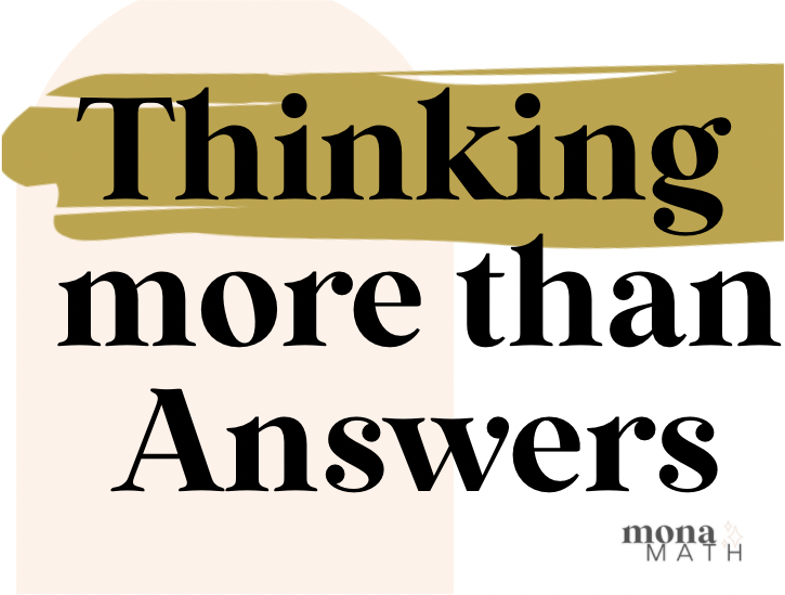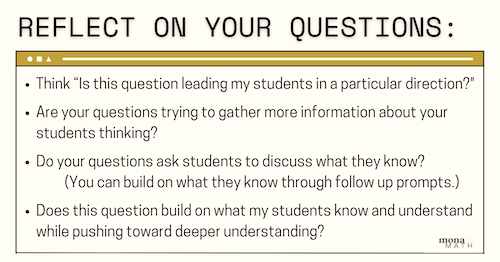Here’s How to Get Kids Talking in Math Class!
By Mona Iehl

We know what works to get those same six students talking and raising their hand each day, but how do we engage every student in truly explaining their thinking and sharing their math reasoning?
1. Consider your types of questions
Asking the right questions can make all the difference. Some questions require little student thinking and focus more on achieving the correct answer.
A common questioning pattern in our classrooms goes like this: teacher asks a question, student answers, and then the teacher evaluates if the answer is correct or not. This is what research calls the “Initiate-Response-Evaluate IRE pattern.” (Cazden, 1988) This quick process lasts only a few seconds and positions the teacher as the evaluator instead of the facilitator of the discussion.
In the NCTM book Principles to Actions, the authors talk about funneling questions that lead students toward a specific idea. Think of the funnel’s wide opening where students enter with various thoughts, approaches, and methods. Then by asking funneling questions, the teacher narrows the students’ understanding to the bottom small opening where there is one right answer.

The reality is that teachers use these types of questions often. We want to help our students be successful and achieve. So we support our students in arriving at the right answer.
However, I would argue that our job is not to help students get to the answers more easily, but instead help our students to think critically and problem-solve. This mindset shift can help us reframe the types of questions we ask – shifting away from helping students to an answer and toward expressing their thinking and building their reasoning skills.
With this shift in our own mindset, we can start to create a classroom that is centered on our students’ thinking and not solely on achieving the answer.
2. Ask open ended questions
Open ended questions allow students to explain their thinking. The focus is not on the answer but on sharing what you’re currently thinking, finding patterns in others’ reasoning, supporting your strategy with reasoning, and justifying your answers.
With the focus on explaining your thinking, all students are positioned to take the first step to participate without the pressure of being right.
Open ended questions invite our students to think, and they encourage students to fully explain themselves. Your questions can be used to help students understand the math task and nudge students toward the key understandings that the task lends itself to. Open ended questions help teachers stay in the facilitator role.
 3. Stay in the facilitator role
3. Stay in the facilitator role
If the goal is to get your students talking, then give them the floor. Plan a time in your classroom to allow for more student talk. This could be turn-and-talk’s or a whole group math discussion. Your students’ thinking and their words are leading this discussion. The questions should build on what they are saying in the discussion.

In this case you will want to ask students to further explain and justify their reasoning using evidence from the models about equivalence. Knowing the standards and the math deeply comes into play big here. You have to know the progression of math understanding so that you can help your students through linking what they know and can do with where they need to go next.
Getting students talking in math discussions means we have to allow students to explore, tinker, and figure out while talking. Resist the urge to step in and explain or “just show you this one thing.” Instead, listen carefully to what students are saying and ask questions to further understand their thinking.
The more you know about what they are thinking the better questions you can ask. The power is in the children’s voices. Let your students explain; let them struggle to explain. Ask the right question and see them work together to develop clarity in their thinking.
Remember your math classroom community
Laying a solid foundation of community in your math classroom will make true math discussions possible. It is a risk for our students to share what they are thinking. Your community must be welcoming, safe, and supportive. Through students’ relationships, norms and routines, this safety can be achieved. If you want more information on how to build a classroom community, check out my earlier MiddleWeb article, 4 Moves to Help Tweens Overcome Math Anxiety.
The less you talk the more they’ll talk
As teachers when we make the conscious choice to listen more and talk less, the results are exciting. Students will start to explain their thinking and give us glimmers of their understanding that we can learn from and build upon.
Mona Iehl (@HelloMonaMath) is a fifth- and sixth-grade math teacher in Chicago, Illinois. Mona started her career 13 years ago teaching in the primary grades but found her home in the middle grades five years ago. Find her other MiddleWeb posts here. Mona recently took her passion for helping teachers and students find their inner mathematician to a podcast. Listen in at @HonestMathChat.




































